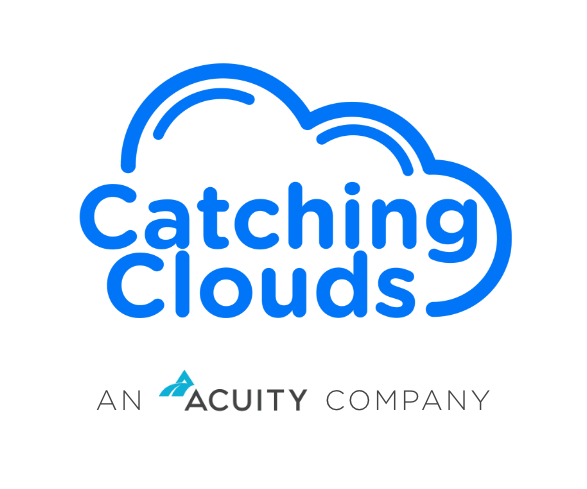Multi-channel clients require a multi-pronged approach

About Catching Clouds, an Acuity Company
Riding the early wave of eCommerce accounting
In 2011, when husband and wife duo Scott and Patti Scharf founded their eCommerce accounting firm Catching Clouds, Amazon dominated the online shopping sphere. Over a decade later, the market has exploded with Shopify, Etsy, Walmart, eBay and international Amazon iterations joining the fray.
As one of the first accounting businesses to specialise in eCommerce, Catching Clouds has gone from strength to strength, taking on larger clients, going beyond simple bookkeeping and recently merging with Acuity.
Almost from the start, Scott and Patti have used A2X along with other tech tools to help them manage the workload, get accurate numbers and offer better options for their clients.
“We’ve just continued to grow and add more value. We’re all about checklists, process and standard tools, and leveraging things like A2X and other tools so we can optimise and deliver a high-value service,” Scott said.
From ‘random clients’ to eCommerce leaders
Catching Clouds’ very first client was an Amazon seller. From there, the company took on a collection of ‘random clients’ before going fully eCommerce 18 months on, establishing a client base of larger eCommerce sellers in the $1M-$50Mrange.
The firm has worked in that space ever since, building a reputation as an industry-leading expert. While other businesses have jumped on board, Catching Clouds had the benefit of being one of the first eCommerce-focused, cloud-based accounting firms.
“We’re the leaders in eCommerce accounting – we’ve been doing it two or three times longer than anyone else. We’ve got that pure focus on eCommerce. We know most of our peers who are out there now – I’ve coached and mentored them in the past,” explains Scott.
Catching Clouds added more and more staff as it took on new clients and eventually added an international offshoring team in 2019. In 2021, the firm merged with Acuity, offering the same service under a larger umbrella.
Before: A2X, the only tool for the job
When Catching Clouds started, Amazon was the focus. Helping clients navigate the notoriously complex and confusing world of Amazon sales records, reconciliations, and monthly payments eventually led the firm to A2X.
Scott explains, “We played around with other tools, and they were just awful. Then we built our own access database, and every week, there was a new Amazon fee. So, we were constantly having to update it, pull data together and figure out how to reconcile everything.”
“We found a few workarounds, but it was really manual and took a lot of time.”
As the client base grew, the time they were spending on reconciliation became unwieldy, and Scott’s ‘IT geek’ instincts kicked in.
“I’m always looking for new technology. I have no idea how I ran into A2X, but I tried it and I was like, ‘That’s awesome!’ We went from taking 30 minutes to an hour per channel, per client, to 10 minutes a month,” he said.
After: more channels, more complexity, effortless accuracy
As the eCommerce market has changed over the years, Catching Clouds’ clients have evolved, too. Where Amazon.com had been the main sales channel early on, clients have become international and multi-channel, adding serious accounting complexity.
“We have clients selling on Amazon around the world, clients with one channel, then some with 15 or 20,” Scott said.
Fortunately, A2X has grown at the same pace, introducing a whole range of channel integrations. This has helped simplify things for Catching Clouds no matter how many channels or currencies a client may be working in.
“All we’ve ever had to do is connect A2X to Amazon, then we connect the multiple accounts to Xero. It pulls in the information and posts it all in US dollars. It’s all consistent and I can look at it per channel,” explains Scott.
He said this is critical information for sellers who may otherwise have little understanding of how their business is performing in different markets.
“We talk to people who have 5,000 SKUs, and they’re selling on multiple channels. They need that information broken down like that so they can look at their businesses and say, ‘Wait, we didn’t sell as much on Shopify, let’s go and fix that issue.’”
Because Catching Clouds has worked with A2X for so long, there is a high level of trust in the numbers coming through.
“It’s still the only tool I trust to give accurate Amazon FBA month-end numbers.”
“We’re firm believers of best-in-breed digital tools”
When the couple decided to move Catching Clouds into eCommerce, Scott says A2X “solidified our decision.” He believes without A2X, they would’ve had a much harder time scaling their business
“The right staff, technology and automation allow us to focus on other challenges like cash flow or budgeting, but not all tools are created equal,” Scott says.
“Most business owners don’t know what their hourly rate is, but most people want to make a good $200k [a year]. That’s $100 an hour minimum. So, do that math – if something takes you six hours to do, that’s $600, instead of paying for a $30 tool.“The more complex your business is, the more automation you need to pull everything together so you can make decisions,” explains Scott. “You need to know if you’re making or losing money in the UK or Amazon Australia. You need those numbers, or you can’t make the best decisions.”
Scott’s advice is to set a budget for tools – and use it! In his words, build the ‘Swiss Army knife of tools’ your business needs to be more productive and scale.
“Sure, you might save $150 a month not investing in a certain digital tool, but you’ve probably lost $1000 in productivity by not leveraging it,” Scott added

